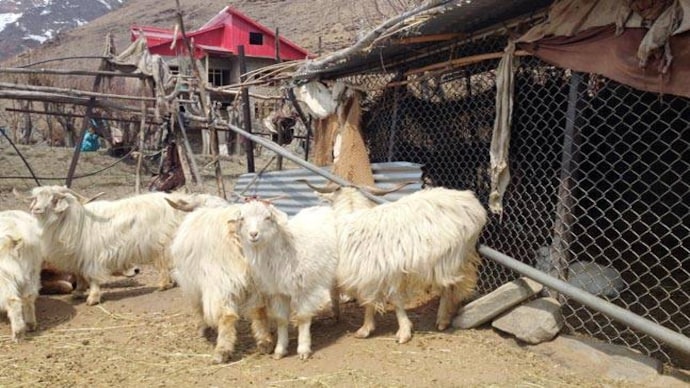Exclusive: Revival of Pashmina industry in J&K gives new hope for economy
Efforts are being made by the Jammu and Kashmir government to revive the most job oriented sector, as raw material for Pashmina shawls comes from Ladakh region of J&K and it is given final touches in Kashmir Valley.

In Short
- Revival for Pashmina industry in Jammu and Kashmir
- Pashmina shawl industry suffered due to machine-made shawls
- Nomads of Kargil and Ladakh region main herders of Pashmina goats
Buying the famous Pashmina shawl of Kashmir has been one of the major charms for anyone visiting the scenic valley or the state. But with a growing availability of cheap imitations of Pashmina shawls in the local markets, the future of the original Pashmina shawl is at stake.
For centuries the Pashmina shawls have been woven on handlooms from wool hand-spun from the shaggy coat of a goat, which lives in the heights of the Himalayas in the Ladakh region of Jammu and Kashmir state. Thousands of Kashmiris are associated with the ancient trade. Women mostly spin and men weave the delicate yarn into warm, soft scarves and shawls, which are often embroidered.
FAKE PASHMINA
Hundreds of Pashmina weavers, however, have felt compelled to take other professions, as cheap and machine-made shawls available around are affecting the demand for the original pieces and particularly the duplicate items available from Amritsar.
Munir Ahmad, a shawl dealer from Srinagar said that the fake shawls especially from Amritsar have put Pashmina trade into the doldrums.
"Thousands of people are associated with this trade. Ladies spin the wool, the men weave the shawls and then there are others who do embroidery on these shawls and the local hawkers sell these shawls. But these days we are facing problems due to the fakes from Amritsar. Due to this everything is in doldrums," said Munir Ahmed.
REVIVAL
Besides, the Pashmina shawl industry has also suffered government neglect at times, adding to the worries of local weavers. But now efforts are being made by the Jammu and Kashmir government to revive the most job oriented sector, as raw material for Pashmina shawls comes from Ladakh region of J&K and it is given final touches in Kashmir Valley.
A sizable portion of goat population of the state viz 3.20 lacks is found in the Leh District of the Ladakh region and major chunk of this goat population comprises of Pashmina/Changra. These goats are reared by Changpas, a nomadic race in Changthang sub division of Leh, Ladakh and Zanaskar valley of Kargil, both areas situated at an altitude of 12000 to 18000 ft. above mean sea level. The area is sandy and mountainous and the atmospheric temperature during winter goes down to (-)40 degree Celsius. The goat is a hardy, sturdy, small dainty animal with quick movements, capable of surviving in difficult conditions. The animal has a short neck and medium sized ears. Horns are narrow towards the tips. The entire body is covered with coarse hair with long fibers on the bridges and shoulders with a fine under coat Pashmina.
Pashmina fibre has a unique position among animal fibres for its fineness, warmth, durability, lightness, softness and ability to absorb dyes and moisture easily. Pashmina is derived from Persian word Pashm and Mina, Pashm means soft and Mina means hair.
SCHEMES
Animal and Sheep Husbandry department of J&K has initiated some incentive schemes among nomads of Kargil and Ladakh region where Pashmina goats are given at subsidised cost to farmers to set up small goat rearing units. This scheme is helping in increasing the number of Pashmina goats in region said Gulam Hyder a farmer in Zanaskar.
"I have got five goats two years back from sheep department and now number of goats has reached to 15. I get half kilo Pashmina from each goat in a year which almost cost Rs 1500 and as the number of goats will increase my income will automatically go up. I got Pashmina goat for Rs 3000 from department while in open market it cost Rs 6000 to 8000," Gulam Hyder added.
Revival of Pashmina industry can be an alternative for the increasing number of unemployed in the state, and it is the industry which is cottage based and provides employment for people in rural and urban areas without involving large infrastructure.